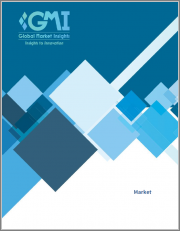
|
시장보고서
상품코드
1351508
복합수지 시장 - 유형별, 강화 유형별, 제조 공정별, 예측(2023-2032년)Composite Resin Market - By Type, By Reinforcement Type, By Manufacturing Process & Forecast, 2023 - 2032 |
||||||
복합수지 시장 규모는 경량성과 강도의 독특한 조합이라는 장점에 힘입어 2023년부터 2032년까지 CAGR 5.7%의 성장률을 나타낼 것으로 예상됩니다.
복합수지 소재는 경량성으로 인해 항공우주, 자동차, 건설, 재생에너지 등 다양한 산업에서 널리 사용되고 있습니다. 자동차의 연비 효율에 크게 기여하고 건물 및 인프라의 구조적 무게를 줄여 비용을 절감하고 지속가능성을 향상시킬 수 있습니다.
복합수지 시장은 유형, 제조 공정, 보강재 유형, 최종 용도 및 지역별로 분류됩니다.
유형별로는 폴리우레탄 기반 복합수지 시장은 뛰어난 내구성과 탄력성으로 인해 다양한 산업에서 채택이 증가하면서 2023년부터 2032년까지 5.5%의 연평균 복합 성장률(CAGR)을 나타낼 것으로 예상됩니다. 이러한 수지는 경량화되어 항공우주 산업 및 자동차 산업과 같은 운송 분야에서 연비 향상에 기여하고 있습니다. 또한, 중국과 유럽에서 환경 규제가 강화됨에 따라 유기 용매를 포함하지 않는 수성 수지에 대한 수요가 증가하고 있습니다.
최종 사용자 수요 증가에 대응하기 위한 업계 기업들의 끊임없는 노력도 이 분야의 성장에 힘을 보태고 있습니다. 일례로 DIC Corporation은 2023년 6월, 표준 수성 폴리우레탄 수지보다 고형분 함량이 높고 아민을 함유하지 않은 친환경 수성 폴리우레탄 수지 '하이드란TM GP'를 출시하여 온실가스 배출량과 휘발성 유기화합물 배출을 감소시켰습니다.
최종 용도별로는 전기 및 전자 분야의 복합수지 시장은 2023년부터 2032년까지 4.5%의 성장률을 나타낼 것으로 예상되며, PCB, 절연체, 전자 부품의 봉지재 등 다양한 응용 분야에서 복합수지 사용이 증가하고 있는 것이 이 부문의 성장에 기여하고 있습니다. 또한, 5G 기술 및 IoT를 포함한 전자제품의 급속한 발전은 고성능, 소형화, 고신뢰성 부품에 대한 수요를 촉진할 것으로 보입니다.
지역별로 보면, 아시아태평양의 복합수지 시장은 2032년까지 5%의 성장률을 보일 것으로 예상됩니다. 급속한 산업화와 도시화로 인해 다양한 산업 분야에서 내구성이 뛰어나고 가벼운 소재에 대한 수요가 급증하고 있습니다. 이 지역에는 자동차 산업이 호황을 누리고 있어 복합수지 수요를 더욱 촉진하고 있습니다.
또한, 에폭시 수지로 인한 가연성 문제를 해결하기 위한 연구 개발 이니셔티브가 진행 중이라는 점도 이 지역 시장 성장을 뒷받침할 것으로 보입니다. 예를 들어, 2022년 9월, ARC 발견 초기 경력 연구자 상 프로그램은 호주 사우스 퀸즐랜드 대학교에 42만1,000달러 이상의 자금을 지원했습니다. 이 자금은 난연성, 저장 안정성 및 기계적 특성을 향상시키는 단일 성분 에폭시 수지를 위한 새로운 유형의 이미다졸/인 올리고머를 개발하는 것을 목표로 했습니다.
목차
제1장 조사 방법과 조사 범위
제2장 주요 요약
제3장 복합 수지 산업 인사이트
- 생태계 분석
- 유통 채널 분석 동향
- 벤더 매트릭스
- COVID-19의 밸류체인에 대한 영향
- 원재료 전망
- 규제 상황
- 기술 상황
- 가격 분석 : 지역별
- 비용 구조 분석
- 업계에 대한 영향요인
- 성장 촉진요인
- 업계의 잠재적 리스크&과제
- 혁신과 지속가능성
- 성장 가능성 분석
- Porter의 Five Forces 분석
- PESTEL 분석
- COVID-19의 업계에 대한 영향
- 러시아·우크라이나 전쟁이 업계에 미치는 영향
제4장 경쟁 구도
- 서론
- 세계 기업의 시장 점유율
- 기업의 시장 점유율, 지역별
- 북미
- 유럽
- 아시아태평양(APAC)
- 라틴아메리카
- 중동 및 아프리카(MEA)
- 시장 경쟁 분석
- 경쟁 포지셔닝 매트릭스
- 전략 전망 매트릭스
제5장 복합 수지 시장 규모와 예측 : 유형별(2018-2032년)
- 주요 동향 : 유형별
- 에폭시
- 폴리에스테르
- 비닐에스테르
- 폴리우레탄
- 페놀
- 기타
제6장 복합 수지 시장 규모와 예측 : 보강 유형별(2018-2032년)
- 주요 동향 : 보강 유형별
- 유리섬유
- 탄소섬유
- 아라미드섬유
- 천연섬유
- 기타
제7장 복합 수지 시장 규모와 예측 : 제조 공정별
- 주요 동향 : 제조 공정별
- 핸드 레이업
- 스프레이 업
- 필라멘트 와인딩
- 수지 트랜스퍼 성형(RTM)
- 인발 성형
- 압축 성형
- 기타
제8장 복합 수지 시장 규모와 예측 : 최종 용도별(2018-2032년)
- 주요 동향 : 최종 용도별
- 자동차
- 항공우주 및 방위
- 건설
- 전기 및 전자
- 해양
- 스포츠 및 레크리에이션
- 풍력에너지
- 기타
제9장 복합 수지 시장 규모와 예측 : 지역별(2018-2032년)
- 주요 동향 : 지역별
- 북미
- 미국
- 캐나다
- 유럽
- 독일
- 영국
- 프랑스
- 스페인
- 이탈리아
- 러시아
- 아시아태평양
- 일본
- 중국
- 인도
- 호주
- 한국
- 인도네시아
- 말레이시아
- 라틴아메리카
- 브라질
- 멕시코
- 중동 및 아프리카(MEA)
- 남아프리카공화국
- 사우디아라비아
- 아랍에미리트(UAE)
제10장 기업 개요
- Hexcel Corporation
- Owens Corning
- Hexion Inc.
- AOC LLC
- Ashland Global Holdings Inc.
- Solvay S.A.
- Huntsman Corporation
- BASF SE
- Sika AG
- Mitsubishi Chemical Corporation
- Toray Industries, Inc.
- SABIC(Saudi Basic Industries Corporation)
- Reichhold LLC
- DIC Corporation
- Polynt-Reichhold Group
Composite Resin Market size is poised to record 5.7% CAGR from 2023-2032 driven by the advantages, such as unique combination of lightweight and strong characteristics. Composite resin materials are widely used in industries such as aerospace, automotive, construction, and renewable energy on account of their lightweight nature. They significantly contribute to fuel efficiency in vehicles and reduce the structural weight of buildings and infrastructure, leading to cost savings and improved sustainability.
The composite resin market is segmented on the basis of type, manufacturing process, reinforcement type, end-use, and region.
With respect to type, the polyurethane-based composite resin market is expected to depict 5.5% CAGR from 2023-2032, owing to increasing adoption across various industries due to their exceptional durability and resilience. On account of their lightweight properties, these resins contribute to fuel efficiency in transportation applications, such as the aerospace and automotive industries. Furthermore, the stricter environmental regulations in China and Europe has led to the higher demand for waterborne resins that don't contain organic solvents.
The constant efforts led by industry players to cater to the rising end-user demands will also propel the segment growth. To cite an instance, in June 2023, DIC Corporation introduced HYDRANTM GP, its new range of environmentally friendly waterborne polyurethane resins with greater solid content than standard water-based polyurethane resins and no amines, to offer lowered greenhouse gas emissions and volatile organic compounds.
Based on end-use, the composite resins market from the electrical and electronics segment is anticipated to exhibit 4.5% growth rate between 2023 and 2032. The increasing use of composite resins for various applications, such as PCBs, insulators, and encapsulation materials for electronic components is contributing to the segment growth. The rapid evolution of electronics, including 5G technology and the IoT is also likely to drive the demand for high-performance, miniaturized, and reliable components.
In terms of regional landscape, Asia Pacific composite resin market is set to record 5% growth rate through 2032. The rapid industrialization and urbanization has surged the demand for durable and lightweight materials across various industrial sectors. The presence of booming automotive industry in the region is further boosting the demand for composite resins.
Moreover, the ongoing R&D initiatives to address the issues of flammability caused by epoxy resins will support the regional market growth. For instance, in September 2022, the ARC Discovery Early Career Researcher Award program funded more than $421,000 to the University of Southern Queensland in Australia. The funding was aimed at the development of new type of imidazole/phosphorus oligomers for single-component epoxy resins to offer fire retardancy, improved storage stability and mechanical properties.
Table of Contents
Chapter 1 Methodology & Scope
- 1.1 Market scope & definitions
- 1.2 Base estimations & working
- 1.3 Forecast calculation
- 1.3.1 COVID-19 impact on forecast, by region
- 1.3.1.1 North America
- 1.3.1.2 Europe
- 1.3.1.3 Asia Pacific
- 1.3.1.4 Latin America
- 1.3.1.5 Middle East & Africa
- 1.3.1 COVID-19 impact on forecast, by region
- 1.4 Data Sources
- 1.4.1 Primary
- 1.4.2 Secondary
- 1.4.2.1 Paid Sources
- 1.4.2.2 Public Sources
Chapter 2 Executive Summary
- 2.1 Composite resin industry 360 degree synopsis, 2018 - 2032
- 2.2 Business trends
- 2.3 Product trends
- 2.4 Application trends
- 2.5 End-use trends
- 2.6 Regional trends
Chapter 3 Composite Resin Industry Insights
- 3.1 Industry ecosystem analysis
- 3.1.1 Distribution channel analysis trends
- 3.1.2 Vendor matrix
- 3.1.3 COVID-19 impact on value chain
- 3.2 Raw material outlook
- 3.3 Regulatory landscape
- 3.3.1 North America
- 3.3.2 Europe
- 3.3.3 Asia Pacific
- 3.3.4 Latin America
- 3.3.5 Middle East & Africa
- 3.4 Technology landscape
- 3.5 Pricing analysis, by region
- 3.5.1 North America
- 3.5.2 Europe
- 3.5.3 Asia Pacific
- 3.5.4 Latin America
- 3.5.5 Middle East & Africa
- 3.6 Cost structure Analysis
- 3.7 Industry impact forces
- 3.7.1 Growth drivers
- 3.7.2 Industry pitfalls and challenges
- 3.8 Innovation & sustainability
- 3.9 Growth potential analysis
- 3.10 Porter's analysis
- 3.10.1 Supplier power
- 3.10.2 Buyer's power
- 3.10.3 Threat of new entrants
- 3.10.4 Threat of substitutes
- 3.11 PESTEL analysis
- 3.12 Impact of COVID-19 on industry
- 3.13 Impact of Russia Ukraine war on the industry
Chapter 4 Competitive Landscape, 2022
- 4.1 Introduction
- 4.2 Global company market share, 2022
- 4.3 Company market share, by region, 2022
- 4.3.1 North America
- 4.3.2 Europe
- 4.3.3 APAC
- 4.3.4 LATAM
- 4.3.5 MEA
- 4.4 Competitive analysis of market player
- 4.5 Competitive positioning matrix
- 4.6 Strategic outlook matrix
Chapter 5 Composite Resin Market Size and Forecast, By Type 2018 - 2032
- 5.1 Key trends, by type
- 5.2 Epoxy
- 5.3 Polyester
- 5.4 Vinyl ester
- 5.5 Polyurethane
- 5.6 Phenolic
- 5.7 Others
Chapter 6 Composite Resin Market Size and Forecast, By Reinforcement Type 2018 - 2032
- 6.1 Key trends, by reinforcement type
- 6.2 Glass fiber
- 6.3 Carbon fiber
- 6.4 Aramid fiber
- 6.5 Natural fiber
- 6.6 Others
Chapter 7 Composite Resin Market Size and Forecast, By Manufacturing Process (USD Billion)
- 7.1 Key trends, by manufacturing process
- 7.2 Hand lay-up
- 7.3 Spray-up
- 7.4 Filament winding
- 7.5 Resin Transfer Molding (RTM)
- 7.6 Pultrusion
- 7.7 Compression molding
- 7.8 Others
Chapter 8 Composite Resin Market Size and Forecast, By End Use 2018 - 2032
- 8.1 Key trends, by end use
- 8.2 Automotive
- 8.3 Aerospace & defense
- 8.4 Construction
- 8.5 Electrical & electronics
- 8.6 Marine
- 8.7 Sports & recreation
- 8.8 Wind energy
- 8.9 Others
Chapter 9 Composite Resin Market Size and Forecast, By Region 2018 - 2032
- 9.1 Key trends, by region
- 9.2 North America
- 9.2.1 U.S.
- 9.2.2 Canada
- 9.3 Europe
- 9.3.1 Germany
- 9.3.2 UK
- 9.3.3 France
- 9.3.4 Spain
- 9.3.5 Italy
- 9.3.6 Russia
- 9.4 Asia Pacific
- 9.4.1 Japan
- 9.4.2 China
- 9.4.3 India
- 9.4.4 Australia
- 9.4.5 South Korea
- 9.4.6 Indonesia
- 9.4.7 Malaysia
- 9.5 Latin America
- 9.5.1 Brazil
- 9.5.2 Mexico
- 9.6 MEA
- 9.6.1 South Africa
- 9.6.2 Saudi Arabia
- 9.6.3 UAE
Chapter 10 Company Profiles
- 10.1 Hexcel Corporation
- 10.2 Owens Corning
- 10.3 Hexion Inc.
- 10.4 AOC LLC
- 10.5 Ashland Global Holdings Inc.
- 10.6 Solvay S.A.
- 10.7 Huntsman Corporation
- 10.8 BASF SE
- 10.9 Sika AG
- 10.10 Mitsubishi Chemical Corporation
- 10.11 Toray Industries, Inc.
- 10.12 SABIC (Saudi Basic Industries Corporation)
- 10.13 Reichhold LLC
- 10.14 DIC Corporation
- 10.15 Polynt-Reichhold Group

















